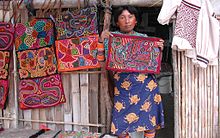MOLAS: textile design & political identity
“Clothes aren’t going to change the world. The women who wear them are.”
– Anne Klein
Clothing is often used to define the wearer’s social class, their politics and indeed, their very view of the world. Traditional dress helps form a nation’s identity as well as furthers its heritage.
In this instance, we explore how two indigenous cultures adapted (or didn’t) to Western influences, political change and the environment.
The Mola or Molas is a hand-made textile that forms part of the traditional women’s clothing of the indigenous Guna people from Panamá. Their clothing includes a patterned wrapped skirt (saburet), a red and yellow headscarf (musue), arm and leg beads (wini), a gold nose ring (olasu) and earrings in addition to the mola blouse (dulemor).[1] Two groups, Choco and Cuna lived side by side without intermarriage and without adopting a similar culture.[2] In Dulegaya, the Guna’s native language, “mola” means “shirt” or “clothing”. The mola originated with the tradition of Guna women painting their bodies with geometric designs, using available natural colors; at a certain point, after the arrival of the Spanish, these same designs were woven in cotton, and later still, sewn using cloth “acquired by trade from the ships that came to barter for coconuts during the 19th century”.[3][4]
history

Molas may have their origin in body painting. In 1514, Pasqual de Andagoya, arrived in Darian and wrote.. the women are very well dressed, in embroidered cotton mantles which extend down so as to cover their feet, but the arms and bosom are uncovered.”[5] They did not wear blouses even in 1688 until they had been introduced by the missionaries.
Only after colonization by the Spanish and contact with missionaries did the Guna start to transfer their traditional geometric designs on fabric, first by painting directly on the fabric and later by using the technique of reverse appliqué. It is not agreed when this technique was first used. It seems to have been popular in the second half of the nineteenth century.[6] In 1924, Lady Brown refers to the dress of the medicine man/ Kantules as “dressed up the knees in long covered with cabalistic characters…all worked into, or let into, the cloth in a form of patchwork.”[7]
As an inspiration for their designs, the Guna first used the geometrical patterns which have been used for body painting before. In the past, they have also depicted realistic and abstract designs of flowers, sea animals and birds, and popular culture.
Depending on the tradition of each island, Guna women or men who identify as women begin the crafting of molas either after they reach puberty, or at a much younger age. Women who prefer to dress in western style are in the minority as well as in the communities in Panama City.
technique
Molas are hand-made using a reverse appliqué technique. Several layers (usually two to seven) of different-colored cloth (usually cotton) are sewn together; the design is then formed by cutting away parts of each layer. The edges of the layers are then turned under and sewn down. Often, the stitches are nearly invisible. This is achieved by using a thread the same color as the layer being sewn, sewing blind stitches, and sewing tiny stitches. The finest molas have extremely fine stitching, made using tiny needles.

The largest pattern is typically cut from the top layer, and progressively smaller patterns from each subsequent layer, thus revealing the colors beneath in successive layers. This basic scheme can be varied by cutting through multiple layers at once, hence varying the sequence of colours; some molas also incorporate patches of contrasting colours, included in the design at certain points to introduce additional variations of color.[8]
Molas vary greatly in quality, and the pricing to buyers varies accordingly. A greater number of layers is generally a sign of higher quality; two-layer molas are common, but examples with four or more layers will demand a better price. The quality of stitching is also a factor, with the stitching on the best molas being close to invisible. Although some molas rely on embroidery to enhance the design, a good looking mola is always constructed using the reverse-appliqué method as the leading technique.[1] A mola can take from two weeks to six months to make, depending on the complexity
cultural, social and political influences
In 1919, the panamanian government began a policy of forced assimilation banning mola’s dress and nose piercing in women. The government introduced these laws to Westernize Guna society and assert control.[13]
There was a strong link between traditional dress and Guna culture and identity. Molas have such an importance for the Guna people and their traditional identity that they can be considered responsible for the independent status of the Comarca Kuna Yala.[14]
After the attempt of the Panamanian government to “westernize” the Guna, the Guna greatly objected to the control on their cultural dress, and ethnic identity, and showed great strength in their reaction to the bans implemented by the government, leading to the Guna Revolution.[13]
In 1925 for three years following the revolution, women were required to once again adopt traditional dress as a form of rebellion against the government. Women on Nargana and other more progressive islands were forced to wear mola, even if they had never worn this traditional dress, and their noses had to be pierced by force.[13]
-
 Greeting Birds Mola-Style Shoulder Handbag$49.00
Greeting Birds Mola-Style Shoulder Handbag$49.00 -
 Crab & Bird Mola-Style Shoulder Handbag$49.00
Crab & Bird Mola-Style Shoulder Handbag$49.00 -
 Cat & Birds Mola-Style Shoulder Handbag$49.00
Cat & Birds Mola-Style Shoulder Handbag$49.00 -
 Mola Glass Cutting Board$22.00 – $30.00
Mola Glass Cutting Board$22.00 – $30.00













